Steph W. from SEOPressor


...help you check your website and tell you exactly how to rank higher?


90
score %
SEO Score

Found us from search engine?
We rank high, you can too.
SEOPressor helps you to optimize your on-page SEO for higher & improved search ranking.
By vivian on July 22, 2015
If you’ve just started an email marketing campaign but seeing low email open and click rates, don’t immediately fire your copywriter.
Just because your click-throughs aren’t converting into sell-throughs, doesn’t necessarily mean your creative is at fault. The problem may be the result of a lack of e-mail marketing best practices.
Not following best practices is like sailing into a hurricane without a life jacket. Your problem may be the result of one or more of these six common e-mail marketing mistakes.
Some may be obvious, some may not apply, but all can contribute to a less-than-successful e-mail push. Correct them and see your conversion rates start to climb.
Imagine you’re planning a wedding. Getting the guest list right is as important as what venue or which caterer you choose.
If you are inviting just family and close friends to the ceremony and then expanding your list for the reception to include cousins and work colleagues, it’s important that you keep those lists straight—or your boss might end up in the first row of the church watching you exchange tearful marriage vows.
You also don’t want to send duplicate invitations to the same family, especially when you consider how much wedding invitations cost these days.
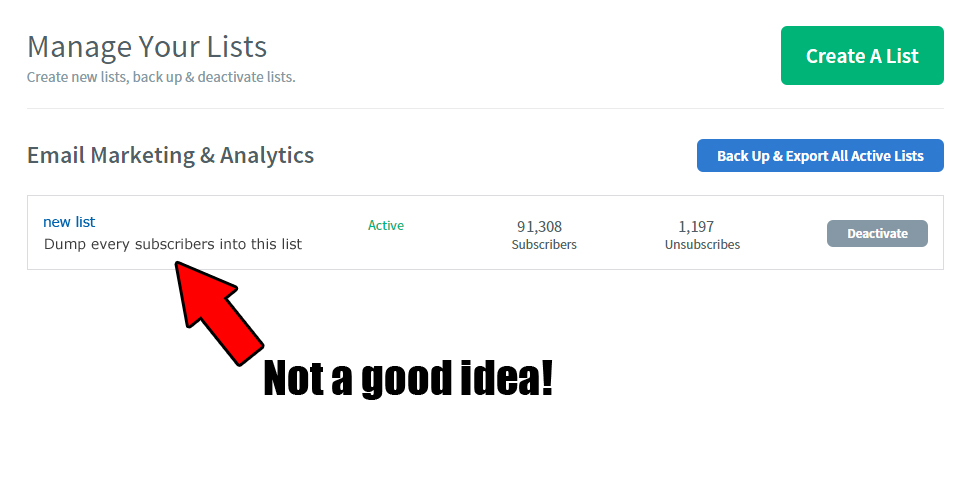
Now consider your e-mail list. When was the last time you actually looked at it? If it’s been a while, you need to make that a regular task on your e-mail marketing best practices list.
Do you have all of your subscribers lumped into one list? Then you’re not taking advantage of proven e-mail strategies like list segmentation and A/B Testing.

E-mail list segmentation allows you to target your message to the most relevant audience.
If you’re a sporting goods store, in addition to sending a general Newsletter that includes all athletics, you might segment your list into tennis, golf, and soccer fans, and send each list offers for deals on just the clothing and gear for that particular sport.
The e-mail marketing service MailChimp looked at a sample of 2,000 e-mails, comparing clients who sent e-mails using list segmentation tools with those clients who used non-segmented campaigns.
They found that “segmented campaigns performed markedly better than their non-segmented counterparts” with open rates that were 13.46% higher and 53.05% more clicks than the non-segmented lists.
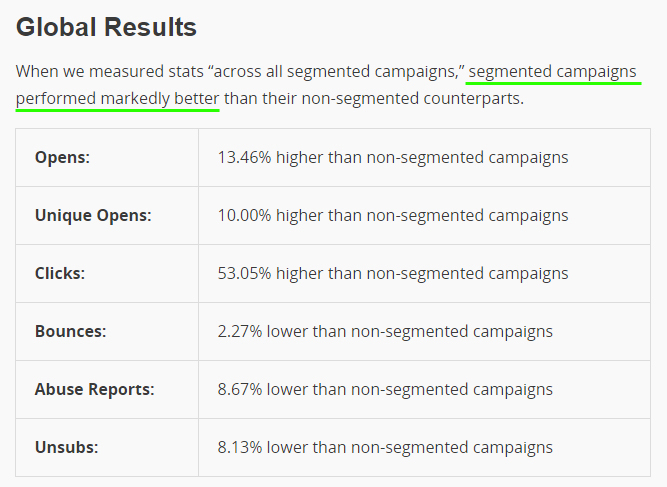
A/B testing is a great way to experiment with different features in your e-mail newsletter to see what garners the most attention.
Randomly split your e-mail list into List A versus List B and send each the same e-mail but with one difference—the e-mail component you wish to test. You can test out subject lines, calls to action, layout, personalization, offers, and more by sending different e-mails to List A versus List B and then analyzing your stats.
This experiment will help you further develop that all-important e-mail marketing best practices list. Psst, if you are looking for some ready application, you can check out these secrets that will get more views for your newsletters.
Also, a common housekeeping error that can lead to users unsubscribing is having duplicate e-mail addresses in your list or the same e-mail address in multiple lists.
Considering that billions of e-mails are sent each day and that most users complain that they get too much e-mail, receiving duplicate e-mails from the same company is a surefire way to irk your customers.
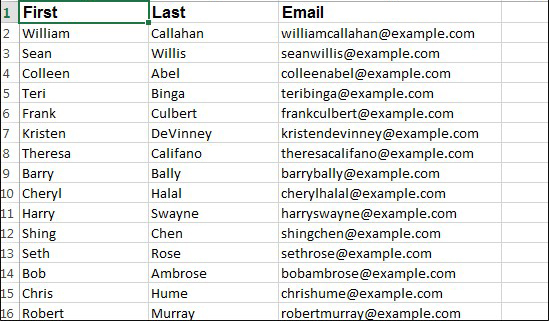
Finally, another of the essential e-mail marketing best practices is keeping your data format (or columns such as “FIRST NAME, LAST NAME”) standardized across all your lists. This will make it easier to personalize your e-mails (more on that later) and store customer data so it’s more accessible. This practice also makes it easier to merge lists or transfer entries from one list to another.
Buying e-mail lists is like a desperate and lonely freshman inviting his or her entire high school class to a pool party. The awkward freshmen might think, “I’m going to get popular by hosting the biggest, most kick-ass party in history!” while the rest of the class is thinking, “Jeff who?”
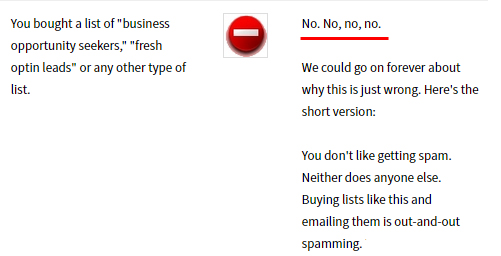
Considering that most e-mail marketing services insist on opt-in addresses only, you’re going to be hard-pressed to find a company that will sell you a good list. More likely, a less-than-reputable company will cheat you by sending you a list of non-active e-mail addresses that will bounce back or end up as spam. Even if you do manage to get some active e-mail addresses, most people do not welcome an unsolicited e-mail from a business. They treat it like junk mail. And there goes your carefully crafted e-mail, straight to the virtual trash bin.
There are better ways to boost your e-mail subscriber list, like offering incentives such as free content, discounts or a contest entry for opt-in subscribers.
If you’ve ever used an e-mail service to send an e-newsletter to a list of the company’s best sales leads, you’ve likely experienced that second of panic when you clicked the button to execute the campaign. At the point of send, it’s usually too late to abort your mission. Any mistakes are now irreversible. If your e-mail doesn’t render correctly when opened, customers might assume Internet illiterates run your business.
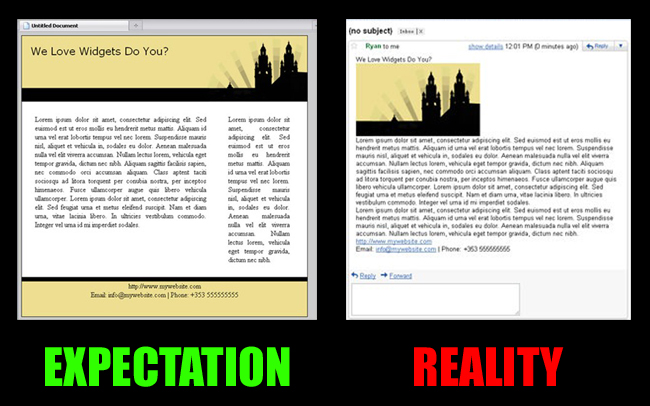
Which is exactly why an essential item on your e-mail marketing best practices list is to test, test, test before you send any communications to your subscribers. Most e-mail servers provide a test e-mail function: use it liberally to send test e-mails to your colleagues with different e-mail clients and browsers. Be sure to see how your e-mail looks on both a Mac and a PC. And offer a text version of your e-mail for those whose e-mail client doesn’t support your HTML.
Not offering the option of a web version of your e-mail will prevent some customers from viewing your e-mail copy the way you intended. It also offers customers no recourse if your e-mail is unreadable or has a glitch.
In the school of e-mail marketing best practices, testing your links is e-mail 101. Users are accustomed to clicking around your e-mail blast and if they end up on a 404 page they’re going to be po’d.
Not only that, but a broken link is a missed opportunity for your business. If the customer clicking on the broken link was considering buying your product or service or answering your call to action, they have probably moved on now.
The design agency BournCreative sums up why broken links are bad for business: “If you regularly publish…your e-mail newsletter with broken links, your audience will soon start viewing your content in a more negative light.”
Before sending any e-mail with links, test every one. This includes hypertext and image links. It’s particularly important to test your links if you are reusing a template from a previous e-mail (a common practice among busy Internet Marketers.) It’s very easy to forget to change a link, resulting in your ‘new’ link leading to a page featured in a prior e-mail.
People are naturally self-interested creatures. We like the sound of our own name. When customers receive an e-mail with their name in the salutation, they feel recognized, counted—even special.
If your e-mail tone is conversational, you improve your chances of drawing them in to read more. This is common sense: most of us would read a letter addressed to us that is warm, funny, and relatable than a non-personal form letter.
If you send an e-mail that is not personalized and reads like a sales flier or a business letter, you’re not drawing anyone in. You may be thinking, of course I wouldn’t write a formal, boring e-mail newsletter. But you’d be surprised how many people think writing good marketing copy is the same as writing a term paper in college—lots of flowery or stilted language and excessive use of impressive but distracting vocabulary words to impress a professor.
More On Writing Conversationally:
Another way to increase your chances of sending an e-mail newsletter that people will actually open is to send it from a personal sender e-mail. Instead of using a sender e-mail address like customerservice@company.com, you send it from a more personal address like danny@company.com. People are more likely to open an e-mail from an actual person than from some anonymous business department.
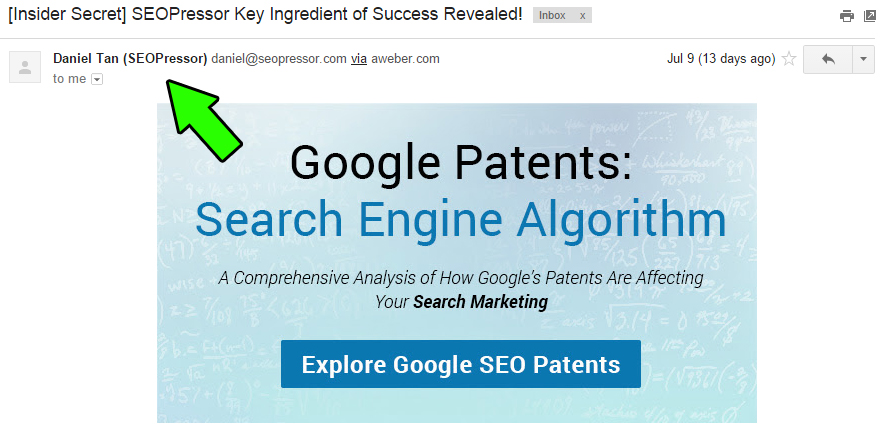
Before you scratch your whole e-mail marketing campaign, consider what principle errors you may be making that might be affecting your results. If you don’t have an official e-mail marketing best practices list, it’s time to create one—and make sure that all six of the common errors you read about here are on it.
A good analogy to the most obvious e-mail marketing errors might be the apocryphal joke about the computer user who calls IT support complaining that their computer isn’t working. When the technician asks if the caller’s computer is plugged in, the user suddenly realizes their ‘big’ problem has a pretty simple solution.
Related Links:
Updated: 4 January 2026


Save thousands of dollars (it’s 100x cheaper)

Zero risk of Google penalty (it’s Google-approved)

Boost your rankings (proven by case studies)
Rank High With This Link Strategy
Precise, Simplified, Fast Internal Linking.
